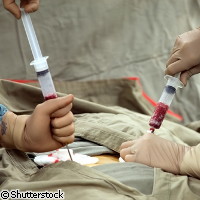Research shows gene interaction can cause aggressive leukaemia
A scientific research team from the Sahlgrenska Academy at the University of Gothenburg in Sweden has discovered that two genes, both of which are known to cause cancer individually, can lead to aggressive leukaemia if they interact. The unexpected results, published in the scientific journal Blood, may lead to new treatments for aggressive forms of leukaemia. Leukaemia is caused by a proliferation of white blood cells in the body. Different forms of the disease exist, including acute and chronic. Some forms are more aggressive than others, such as acute myelogenous leukaemia (AML). With leukaemia the affected white blood cells sometimes invade other organs in the body, often the lymph nodes, liver or spleen, leading to a seriously depleted immune system. In Sweden, approximately 900 people are diagnosed with leukaemia every year. The team made its discovery while carrying out experiments on gene-modified mice. While the two genes under investigation are often present in a mutated form in acute leukaemia, the mutations rarely occur together. Scientists previously believed that the mutated genes caused the same reaction - increased activity of a carcinogenic protein called RAS which causes blood cells to proliferate more rapidly. 'This is a surprising discovery that suggests that there is a mechanism behind the development of cancer that has not yet been recognised. It opens up the way for new methods of fighting blood cancer cells with NF1 mutations,' said Professor Martin Bergö, who led the research at the Sahlgrenska Academy, One of the two genes concerned codes for the RAS protein and the other codes for a protein called NF1. The latter is known to reduce the activity of the RAS protein. The Sahlgrenska team had worked previously with two different types of mice. One type had the RAS mutation and the other the NF1 mutation. The team observed the slow development of leukaemia in both types of mice. But when they combined the two, they saw a highly aggressive form of leukaemia development in mice with mutations in both the genes. 'The corresponding increase in the RAS signalling cannot explain the severe increase in disease aggressiveness and this means that the NF1 protein may play a different role in the development of the leukaemia than we originally thought, and may not involve the RAS protein at all,' said Professor Bergö. 'The discovery opens the possibility of developing new treatments for patients who have mutations in NF1.' Working with another team from the Sahlgrenska Academy, the researchers are now investigating the role that the NF1 protein plays in order to be able to develop new treatments for aggressive leukaemia.
Countries
Sweden



